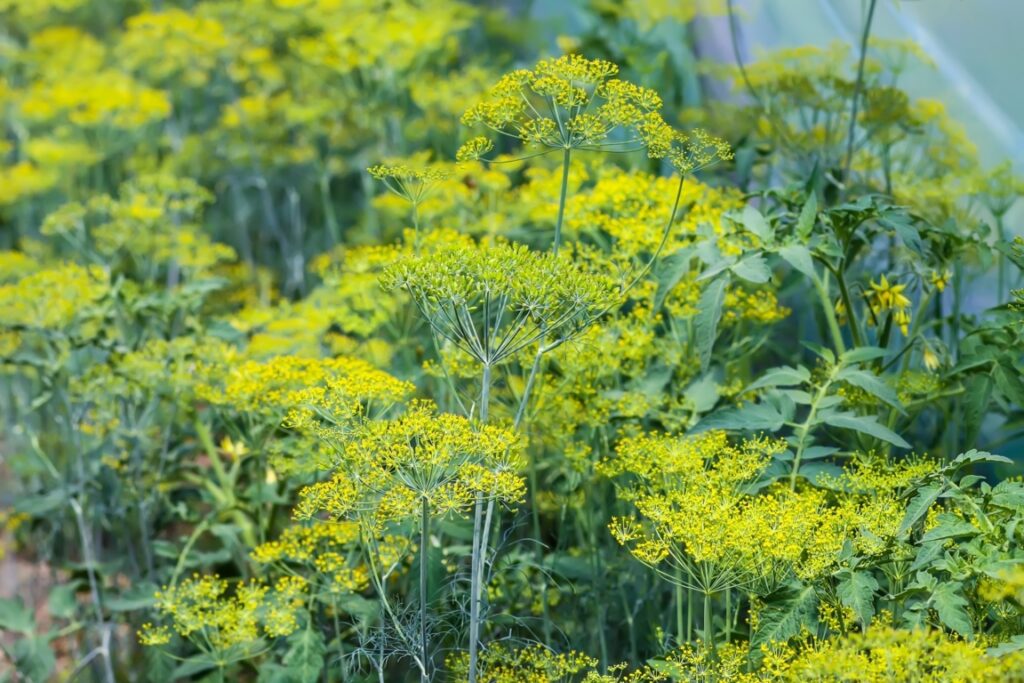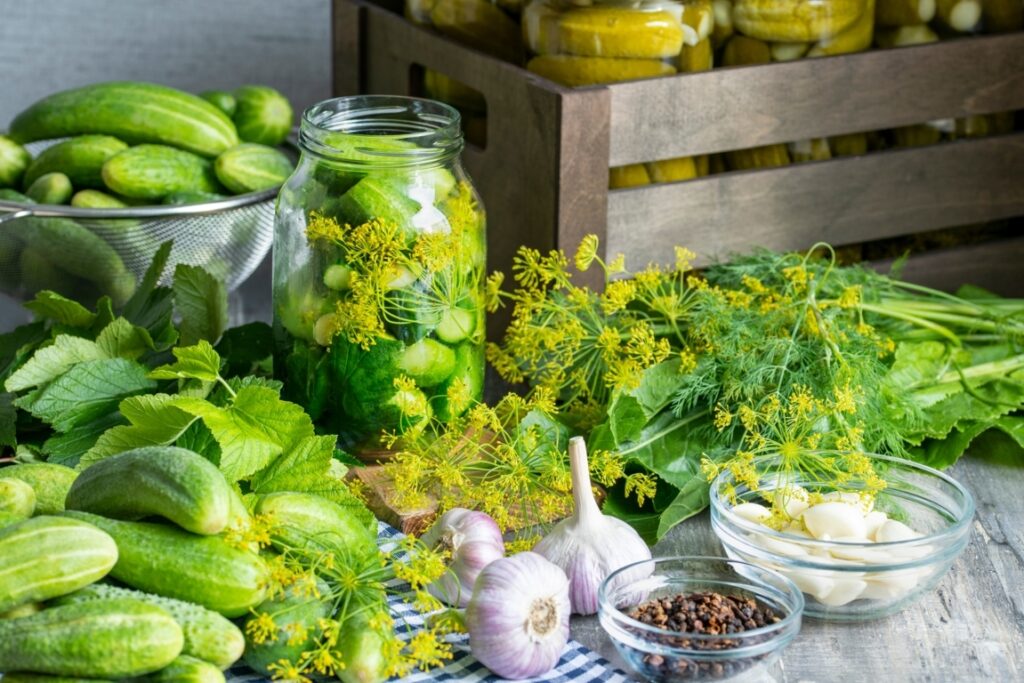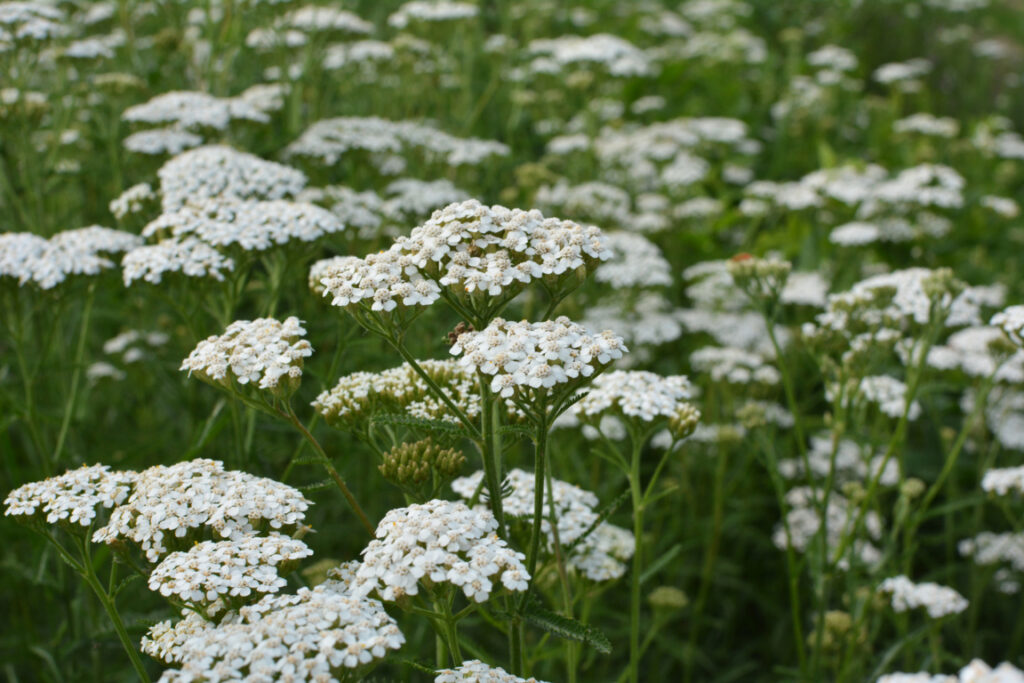
By far one of the most versatile herbs, dill is a staple in my gardens every year. Most of the time it sprouts up voluntarily in the spring because the seeds readily self sow and spread. I love to pluck the young fern-like greens and pop them into my mouth as I mosey about completing garden tasks. The crisp, tangy taste is so refreshing!
If this were the only feature of dill, it would still be worth growing. But the long list of botanical benefits dill offers may surprise you. I’ll even venture to say that it’s as close to an ultimate companion plant as you can get.
So without further delay, let’s jump right into the wonderful world of dill!
The Advantages of Planting Dill in your Garden
The most observable advantage of dill is the type of insect company it keeps. Take a quick glance at a dill flower head in the middle of a sunny summer day and try to identify all of the bugs buzzing around it.
I’m sure you can’t!
It’s simply stunning the diversity dill invites into your garden.
The beneficial insects dill hosts work hard at providing pollination and protection. Honey bees, hoverflies, parasitic wasps, praying mantis, ladybugs and butterflies will make a home out of a dill patch all while fertilizing and guarding your garden.
Dill not only keeps good company, it doesn’t run with bad crowds either. Aphids, spider mites and cabbage loopers are driven off by dill.

The following are some suggested dill plant mates by gardeners:
Onions and Garlic
Plants of the genus Allium do a great job of keeping away aphids. Planting dill among a row of onions or garlic is a great way to keep away one of the few pests that bother dill. Alliums and dill should be teamed up with asparagus to make a formidable triumvirate.

Asparagus
Dill is a staunch ally when it shares company with asparagus. The big dill heads, full of tiny flowers, call to arms beneficial insects like ladybugs and lacewings. These two stalwart soldiers will defeat any aphid invasion threatening your asparagus crop.

Cucumbers
During the hot summer months it’s difficult for cucumber plants to get all the water and nutrients they need to keep producing their cool green fruit. If they become stressed, there’s no doubt they’ll be afflicted by cucumber beetles or spider mites. Don’t let any invasion start in the first place by keeping dill close by. The beneficial wasps that dill host are prime predators of these common pests.
The flavor of cucumbers can even be enhanced when growing alongside dill. It’s no wonder the two crops pair as naturally in the garden as they do pickled in a jar.

Basil
Basil and dill get along fine in the garden. They can be interspersed freely and will help enhance the flavor of one another.
Yarrow
Yarrow has similar growing habits of dill. Stalks shoot up tall and explode with widely spaced flower heads. It can be taken care of easily alongside dill while attracting an even broader spectrum of beneficial insects. The extra pollinators brought in by yarrow enhance the life force and efficacy of dill’s own strengths.
The ladybugs that are guests on yarrow flowers will combat dill’s other arch nemesis, armyworms. Our spotted garden friend employs a sneak attack and devours armyworm eggs before they can hatch and do any damage.

Brassica Vegetables
Broccoli, cabbage and cauliflower will grow well alongside dill. These vegetables are always susceptible to cabbage loopers. Moths lay eggs inside their developing heads. Hungry, hungry caterpillars eventually hatch and voraciously feed on the tender and lush, young vegetation. Dill solves this issue by reliably driving off the moths or, at worst, acting as a decoy.
Dill and brassicas have a similar growing cycle, enhancing the flavor and vigor of each other. They can be harvested together with enough time for another round of each to be planted for a fall crop.

Tomatoes
Tomatoes, we’re on the trellis about. Planting dill next to tomato plants has its pros and cons. Dill deters tomato pests, but the two also stunt each other’s growth as they mature.
One solution is to plant dill early in the spring. This way it matures and can be harvested well before competition for space with ripening fruit becomes an issue. Beware of weeds that look like tomato plants.

What Not to Plant with Your Dill
It’s hard to believe the easy going, amiable herb doesn’t get along with all plants. Yet again, dill’s botanical superpowers are bound to warrant an arch-nemesis or two.
One in particular that stands out is lavender. Dill is a fast growing, aggressive sun seeker. Lavender is more patient, growing little vegetatively year to year, and requires space and resources to push up its purple spikes in the summer. Dill’s leafy fronds and towering flower heads quickly shade out the stocky lavender shrubs.
The wet conditions and excess water that dill will lap up are deathly dangerous to lavender. The two, due to their respective natures, just can’t coexist in the same space.
Carrots, cilantro and dill should all be grown separately. Close contact will lead to excessive cross pollination that brings about unpleasant tasting flavors in the herbs and carrots. Because they are all of the same family, this case of cross pollination is far from ideal.
Fennel, a member of that same family, doesn’t get along with any crop. It emits a chemical that stunts the growth of any nearby plant.
Other than those few listed above, dill is still rated a 10/10 as far as companion plants go. In every garden there’s a border, corner of a bed, or even crack in the walking path for dill to subsist.
Dill Deserves a Spot in Every Garden
Dill’s merit as a companion plant and necessity in the kitchen makes it an indispensable herb to grow in the home garden. Seeds are easy to come by and reproduce like mad. So don’t wait for next season, sow some dill seed in your garden this spring and watch your garden thrive.
Frequently Asked Questions (FAQ)
Where should I plant dill?
Dill is not a fussy plant, but there are a couple specifications it prefers. Plant dill in a sunny site that offers some protection from strong gusts of wind. Seeds should be sown where the plant is intended to grow, as it does not tolerate transplanting well.
Why do I struggle to grow dill?
Dill should be directly sown early in the spring. Cool and wet weather will help it germinate and establish a root system before it has to endure excessively hot and dry conditions.
Will dill regrow next season?
Dill is not a perennial, but it does self sow incredible amounts of seed every fall. Seeds can be collected or left to scatter in place or throughout the garden. There are bound to be new dill plants sprouting up in unexpected places every spring. To collect the seeds, just clip the heads and shake them out into a paper bag.
Does dill need lots of room to grow?
Dill will grow somewhat large and bushy, but individual plants can fit into pretty tight spaces. Dedicate a small patch of dill and let it sprout up wild in other convenient places.
Can dill be cut without killing it?
Dill can be harvested effectively by snipping off the lowest green fronds as plants grow taller. When the flower heads form, leave them for the pollinators, and some for seed saving, but snip a couple to get more foliage from a few of your plants.



